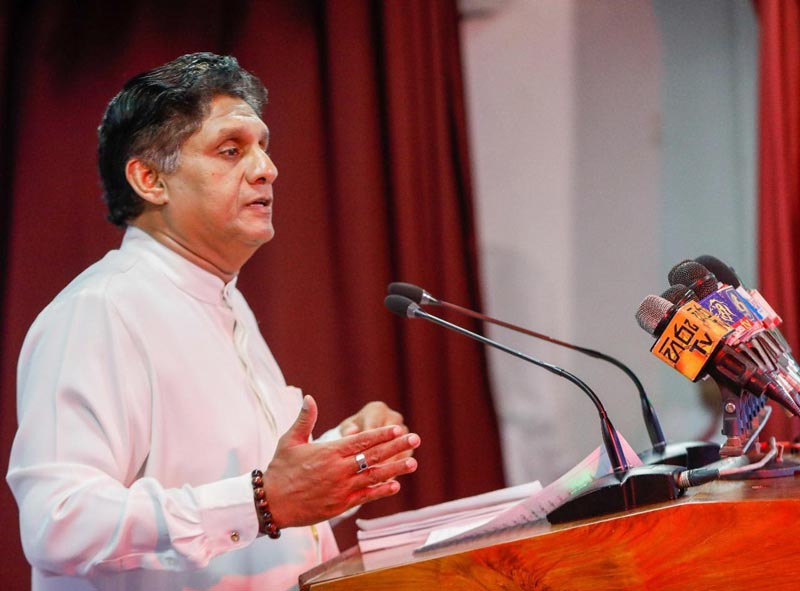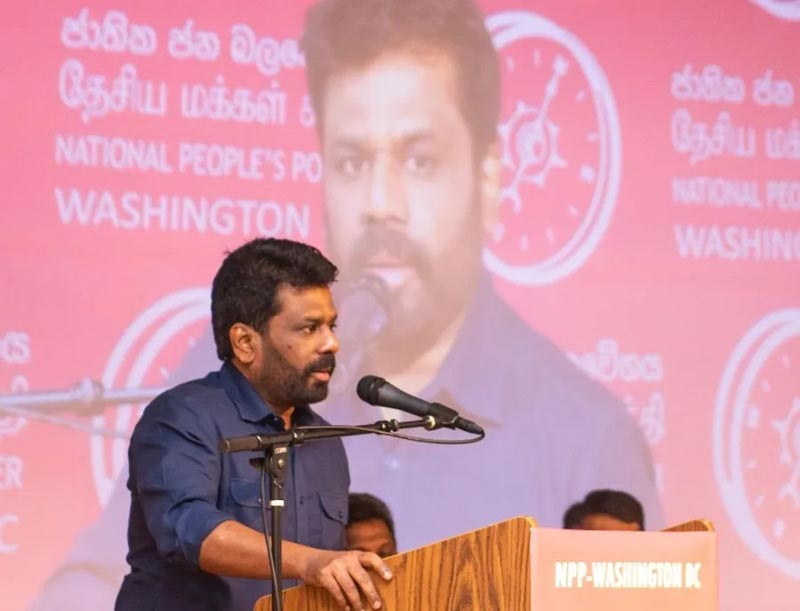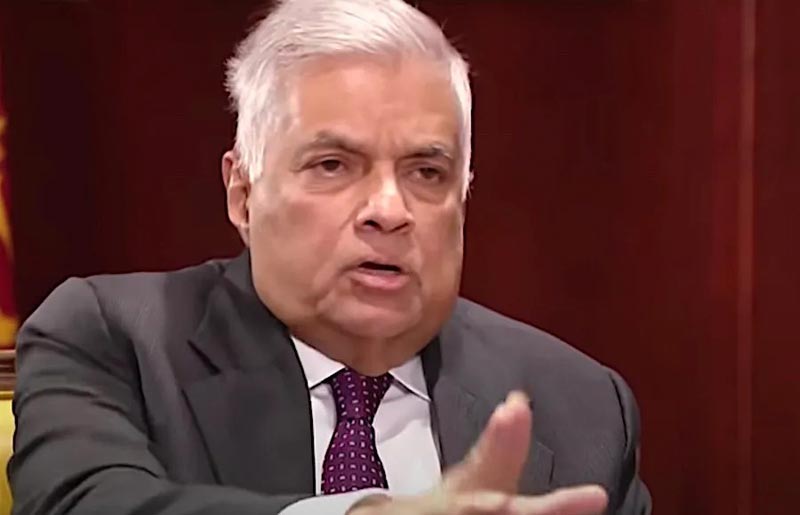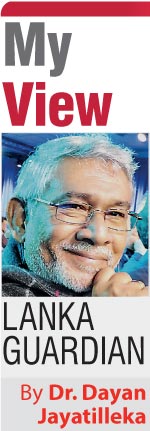Friday Nov 28, 2025
Friday Nov 28, 2025
Thursday, 21 December 2023 01:53 - - {{hitsCtrl.values.hits}}

Needs Janasaviya-2

2024 as Vimukthi Vasara?

Can’t pamper 1% and win
“Sri Lanka is in the top one third of the highest unequal countries in the world.
The top 1 % of Sri Lankans own 31% of the total personal wealth in the country.
The bottom 50 % only owns less than 4 % of the overall wealth in the
country.”
– Dr. Vagisha Gunasekara, UNDP –
 While the people’s main burden and the main target of their invective is Ranil’s economic policy which is ravaging their lives, the SJB targets the JVP-NPP and Anura Dissanayake much more than it does Ranil’s policies. Perhaps this is why UNP Chairman Vajira Abeywardena proclaims “the current Opposition is also ours”. (https://www.ft.lk/top-story/Presidential-stakes-hot-up/26-756516)
While the people’s main burden and the main target of their invective is Ranil’s economic policy which is ravaging their lives, the SJB targets the JVP-NPP and Anura Dissanayake much more than it does Ranil’s policies. Perhaps this is why UNP Chairman Vajira Abeywardena proclaims “the current Opposition is also ours”. (https://www.ft.lk/top-story/Presidential-stakes-hot-up/26-756516)
The JVP and I were bitter enemies when it was at its most violent and ideologically extreme. Wijeweera’s JVP killed my comrades and friends. At the time I strained every nerve fighting him politically, ideologically and strategically. Wijeweera had more consecutive pages (5) denouncing me by name in his magnum opus on Marxism & the Tamil Question, than he had on Velupillai Prabhakaran. None of those attacking the JVP hysterically today from right-wing positions (SLPP, UNP, SJB), accusing it of ‘extreme socialism’, have that history, those credentials. Therefore, it amuses and annoys me to hear their shrill, ignorant, misplaced and misleading denunciations of Anura Dissanayake and the JVP-NPP.
I have observed the JVP’s positive evolution and it reminds me of the Provisional IRA and its political-electoral wing, Sinn Fein. The JVP-NPP today is like the Sinn Fein, and Anura Dissanayake and his comrades are taking the Lankan version of the Gerry Adams-Martin McGuinness route. (By the way, I interviewed McGuinness twice).
|
UNDP Country Economist Dr. Vagisha Gunasekara
|
Parliamentary election first
A leading Sunday paper reported a fissure in the Freedom People’s Congress (FPC) over the SJB’s unwillingness to accommodate its request for a more progressive economic platform.
‘Dr Harsha de Silva…said the party has already presented two blueprints for the economy at various junctures, and a third proposal would be presented in February...De Silva notes the SJB is willing to work with any party at the election that agrees to its economic agenda and is free of corruption.’ (https://www.ft.lk/front-page/2024-offers-multiple-challenges-election-mantras-will-not-solve-Harsha/44-756464)
Any party that “agrees to its economic agenda” needn’t ally with the SJB; it can merge with it. Conversely, “agreeing to its economic agenda”-- the ‘blueprints’-- cannot be the basis of a political alliance. That requires a broader consensus platform on economic policy.
The failure of the protracted SJB-FPC talks and closing window for a Sajith-Dullas partnership provide an opening for a political breakthrough by Anura Dissanayake and the NPP. Politically, the heavy-hitters in the FPC are Dullas Alahapperuma and Prof. Charitha Herath. If Anura wins over this grouping he may secure a ‘swing factor’.
The JVP has valuable political experience in a centre-left bloc led by the centre ( CBK, MR) Now, instead of a centre-left, history provides the portal for a left-centre under Left leadership, that of AKD-NPP-JVP. That’s the chance the Left pioneers disastrously spurned at Sri Nissanka’s residence ‘Yamuna’ in 1947.
The SJB attacks Anura and the JVP on the grounds that they helped bring Mahinda Rajapaksa into office in 2005 while the pristine SJB comprises those who never once sullied themselves by supporting Mahinda. That’s ironically self-incriminatory. If MR didn’t win in 2005, Prabhakaran would have. The SJB-- at the time UNP-- never supported MR, but they did support Ranil who supported and saved Prabhakaran.
While UNP, SJBers detested Mahinda more than they did Prabhakaran who had murdered Ranasinghe Premadasa, Ranjan Wijeratne, Gamini Dissanayake and Lalith Athulathmudali. When the decisive existential choice before the nation in wartime was ‘MR or Ranil?’ today’s SJBers opted for Ranil. In 2005, the voters and the JVP were right.
 “Dr. Harsha De Silva said he anticipates the general election to take place first.” (ibid)
“Dr. Harsha De Silva said he anticipates the general election to take place first.” (ibid)
A fortnight earlier, on Siyatha TV’s Aluth Katha (Dec 5th) I speculated precisely on that ‘snap election’ scenario, suggesting that in the public interest it would be tactically smarter for the electorate to pre-position the NPP as majority party in Parliament and catapult Anura in as PM, while deciding on the presidency after the candidates’ TV presentations and debates. (https://www.youtube.com/watch?v=GW8Djw2-zXA)
Whose recovery?
President Wickremesinghe is brimming with satisfaction over his economic stabilisation and recovery efforts. Going by all available reports, whatever and whoever is ‘recovering’ or ‘stabilising’, it is neither the citizenry at large nor Ranil’s popularity.
The IMF is more lucid about future prospects than Wickremesinghe.
 “Social unrest could re-emerge, fuelled by falling real incomes, including from tax rate hikes and cost-recovery pricing in the energy sector, insufficient anti-corruption efforts, and delayed local elections” the report said.’
“Social unrest could re-emerge, fuelled by falling real incomes, including from tax rate hikes and cost-recovery pricing in the energy sector, insufficient anti-corruption efforts, and delayed local elections” the report said.’
(https://economynext.com/sri-lanka-risks-have-increased-social-unrest-could-re-emerge-imf-report-143594/)
Another newspaper reported:
 “The IMF expects Sri Lanka’s economy to contract by 3.6% by the end of 2023, surpassing their earlier projection of a 3% contraction and the Central Bank’s expectation of a contraction between 1-2%…Moreover, it said that inflation is expected to edge up to 4.8% by the end-2023 following the 18% electricity tariff hike in October while further increases are projected in 2024 up to 6.6% due to tax policy measures such as the Value Added Tax (VAT) rate increases...”
“The IMF expects Sri Lanka’s economy to contract by 3.6% by the end of 2023, surpassing their earlier projection of a 3% contraction and the Central Bank’s expectation of a contraction between 1-2%…Moreover, it said that inflation is expected to edge up to 4.8% by the end-2023 following the 18% electricity tariff hike in October while further increases are projected in 2024 up to 6.6% due to tax policy measures such as the Value Added Tax (VAT) rate increases...”
Would you bet on an incumbent or administration imposing 18% VAT, surviving an election within the year?
Inequality shock, economic injustice
I was shocked and saddened when I looked in the mirror of the latest report by an unimpeachable, universally respected ‘flagship’ UN organisation. According to the UNDP’s new report, we have nose-dived and crashed as a society in a cardinal respect: Inequality.
The presentation came from the UNDP’s Country Economist who is one of the island’s most crystalline minds and articulate speakers in the field of political economy: US-educated Dr. Vagisha Gunasekara. In a meritocratic Sri Lanka, she would be Finance Minister. For a better Sri Lanka, she should be.
‘Fragile and uneven economic recovery has further exacerbated income and wealth inequalities in the country, placing Sri Lanka among the top five most unequal countries in the Asia Pacific, according to the United Nations Development Programme (UNDP).
… “In the context of Sri Lanka’s economic crisis, multiple assessments and simulations speculate that previous poverty reduction gains may now be lost,” said Dr. Vagisha Gunasekara, Country Economist from the UNDP Policy and Engagement Team.
Even before the economic crisis, the country was grappling with prevalent disparities and enduring structural exclusions, including entrenched inequality, gender biases, and a sizable informal sector. These challenges were further exacerbated by the pandemic and economic crisis, compounded by rising inflation resulting from geopolitical conflicts. On top of this, the region and Sri Lanka are facing a triple planetary crisis— climate change, pollution, and biodiversity loss, which are hitting the most vulnerable populations the hardest.
Dr. Gunasekara highlighted that high income and wealth inequalities, which remain persistent, specially after the pandemic and economic crisis, are major concerns for the country.
“Sri Lanka is…in the top one third of the highest unequal countries in the world, and wealth inequality is also very high. For example, the top one percent of Sri Lankans own 31 percent of the total personal wealth in the country, while the bottom 50 percent only owns less than 4 percent of the overall wealth in the country. This provides us with a snapshot of how unequal our country is,” she noted.
These remarks were shared at the national launch of UNDP 2024 Asia-Pacific Human Development Report, titled ‘Making Our Future: New Directions for Human Development in Asia and the Pacific,’ held in Colombo.
According to the report, Sri Lanka is among the top five countries exhibiting the highest wealth inequality, as measured by the wealth share of the top 10 percent, along with Thailand, China, Myanmar, and India.
Although Sri Lanka scored 0.782 in the Human Development Index (HDI) in 2021, gaining 0.002 points over the previous year with a rank of 73, Dr. Gunasekara pointed out that the country loses 10.6 percent points when the HDI is adjusted for inequality.’
Dr. Gunasekara then focused on the phenomenon of galloping household indebtedness.
‘…she also expressed concerns about the looming indebtedness of the population, with 33.4 percent of the populace grappling with vulnerability and deprivation concerning debt-related metrics.
The primary catalysts behind incurring debt included economic activities (42.5 percent), housing construction or repair (32.8 percent), and basic consumption of food, fuel, and other household expenses (19.3 percent).
For households seeking funds for consumption, the primary sources of debt include pawning (31.1 percent), money lenders (24 percent), and banks (23.5 percent). In particular, urban areas had a higher proportion of households that borrowed for basic consumption (26.2 percent) compared to rural areas (17.9 percent).’ (ibid)
The UNDP Report crucially recommends a strategic policy re-set.
‘The UNDP report recommended mainstreaming human development, recalibrating growth strategy, and making change happen as the way forward.
To make this happen, Dr. Gunasekara stressed that the government needs to expand people’s choices by focusing on governance, enhancing civic engagement, and eliminating discrimination, while enhancing human security through social protection programmes and insurance and risk finance tools, and accelerating the transition towards carbon-neutral and climate-resilient development.’ (ibid)
The ‘inequality shock’ cannot be attributed to low income, because when we had a lower growth-rate and income, we didn’t have anything like this unconscionable level of inequality.
Meanwhile people eat less, and badly.
‘…Clinical Nutrition Specialist Dr. Renuka Jayatissa…said “…We estimate that 70 per cent of people are having hardships to reach a healthy diet…During the current economic crisis, the micronutrient gap is getting wider due to high prices of foods...approximately half of the Sri Lankan population has some form of micronutrient deficiencies...Micronutrient deficiencies lead to potential impacts on human health and nutrition which are life threatening…Millions of people will be more vulnerable to micronutrient deficiencies due to diet with less diversity.”‘
The collapse in the wealth share of the bottom 50% as spotlighted by the UNDP’s Dr Vagisha Gunasekara reveals not merely appalling asymmetry but also explosive economic injustice.
 The bottom 50% contributes far more to the national income than the paltry 4% it receives of national wealth.
The bottom 50% contributes far more to the national income than the paltry 4% it receives of national wealth.
 The top 1% which has 31% of the wealth, doesn’t seem to be contributing 31% of the tax revenue.
The top 1% which has 31% of the wealth, doesn’t seem to be contributing 31% of the tax revenue.
 The VAT will hit both the top 1% and the bottom 50% equally, though with shatteringly unequal consequence.
The VAT will hit both the top 1% and the bottom 50% equally, though with shatteringly unequal consequence.
The inequality chasm also reflects, and causes, a shrinkage of purchasing power and consumer demand, which accelerates the downward spiral.
Unlike in China and India, inequality in Sri Lanka doesn’t accompany a rapid rise in general prosperity, but does accompany plummeting growth, nutrition levels and school attendance.
Social indicators will worsen when the Wickremesinghe administration or a neoliberal successor accedes to the bond-holders demands next year.
‘Sri Lanka needs to enter into agreements with its official and private creditors before the second review of the Extended Fund Facility (EFF), which is expected to be concluded by the end of the first half of next year, IMF Senior Mission Chief for Sri Lanka, Peter Breuer said.
He said the agreements that have been entered with creditors in-principle need to be converted into real agreements before the second review. The IMF team …is expected to finish the second review by June.
Sri Lanka has entered into in-principle debt restructuring deals with the Official Creditor Committee (OCC)...However, Sri Lanka is yet to strike a deal with its commercial creditors or the bondholders…’
Through its ISB bulge, the Yahapalanaya UNP of PM Ranil Wickremesinghe and his economic team contributed greatly to the crisis that engulfs us. Logically, the SJB economic troika which was present during and still defends that surge cannot be trusted with the task of rescuing us from this abyss, not least since there is no guarantee this unacknowledged, unconscionable folly will not be repeated.
Re-balance for fair play
Social science literature confirms that when a society which is accustomed to a relatively fair share-out of wealth suddenly turns greatly unequal, it triggers rebellions, even revolutions.
The solution, in the UNDP’s language, is “mainstreaming human development, recalibrating growth strategy, and making change happen as the way forward.”
We’ve “recalibrated growth strategy” and “mainstreamed human development” before, and to good effect, in the late 1980s-early 1990s. There too a UN report was the catalyst.
President Premadasa’s poverty reduction program Janasaviya, rolled-out during the presidential election campaign of 1988, was his response to the Report of the Warnasena Rasaputram Commission on Poverty appointed by him as Prime Minister. The Rasaputram Commission was appointed after Premadasa had been shocked by a new UN report on poverty, inequality and nutrition, almost a decade of the UNP’s Open Economy.
Janasaviya stemmed from Premadasa’s explicit development philosophy that the broad base and not the narrow apex of the social pyramid should be the priority focus of economic policy. If the base was uplifted, so would be the whole pyramid. If the base sank so too would the entire pyramid.
On a panel in Colombo with the new PM in 2015, Nobel Prize winner Joe Stiglitz advised Ranil Wickremesinghe and his economic team (including the current SJB Economic Council) that “equity” should guide Sri Lanka’s ‘post-conflict economic strategy’. He was ignored and Ricardo Hausmann preferred. The latest UNDP report proves Stiglitz right, retrospectively and prospectively.
Paradoxically the SJB founded and led by President Premadasa’s son, is not presenting an economic policy agenda which “mainstreams human development” through “recalibrating growth strategy”--a classic Ranasinghe Premadasa move. Instead, the SJB’s economists and economic program wax nostalgic about Ranil’s policy model of 2001-4 and 2015-2019 (“our government”), while tacitly accepting his current vision.
While Sajith occasionally mentions ‘social democracy’, Harsha-Eran-Kabir studiedly shun it and instead emphatically use the term ‘social market economy’ which Ranil introduced to Sri Lanka (and them) and continues to deploy. Social Democracy and ‘social market economy’ belong to competing ideological-political histories and ‘extended families’; they aren’t synonymous or interoperable.
When, at a glitzy conclave of the SJB’s umbrella organisation of professionals, Prof Lakshman R Watawala glowingly recounted his experiences of helping implement President Premadasa’s policies, criticised the SJB for hardly mentioning them, and urged Sajith to follow in his father’s path, fulfilling Premadasa’s vision and mission, Eran Wickramaratne flatly contradicted him, declaring “that was then; policy will be collegiate now”.
If Sajith continues to patronise and propagate the Harsha-Eran model instead of pivoting to his late father’s, he’s making the politico-existential choice to front an unsuccessful, unpopular, elitist Establishment project in decline, rather than revive a successful, pro-people, progressive one.
Lenin’s death centenary/Vimukthi Vasara
January 2024 marks Lenin’s 100th death anniversary. Anura and the JVP-NPP should:
 Launch a 21st century version of Lenin’s New Economic Policy (NEP).
Launch a 21st century version of Lenin’s New Economic Policy (NEP).
 Adopt Lenin’s United Front policy unveiled in 1920 for national liberation struggles (Comintern 2nd Congress) and 1921 against capitalist counterrevolution/ incipient fascism (Comintern 3rd Congress).
Adopt Lenin’s United Front policy unveiled in 1920 for national liberation struggles (Comintern 2nd Congress) and 1921 against capitalist counterrevolution/ incipient fascism (Comintern 3rd Congress).
With Lenin’s death, the United Front concept was abandoned until 1935, and Fascism assumed power. If AKD and the JVP-NPP adopt both the NEP and the United Front, Lenin’s death centenary year-- 2024--can become Sri Lanka’s Vimukthi Vasara, the Year of Liberation.